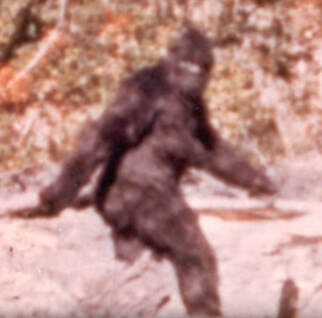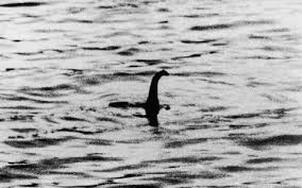|
Cryptozoology is a term invented by the late French-Belgian scientist Bernard Heuvelmans (who is known as the father of cryptozoology), and it literally means the study of hidden animals, or animals not yet known to science. This discipline in principle may not sound like anything controversial. After all, new species of living organisms are discovered all the time, and some of these have proven quite remarkable. The poster boy of cryptozoology is the coelacanth. The coelacanth is an ancient fish that was thought to have gone extinct about 66 million years ago and was only known from fossils, but the finding of a specimen of this fish off the coast of South Africa in 1938 caused a global sensation. Over the years more coelacanths have been caught and studied revealing amazing attributes of these fishes that are more closely related to mammals than to other fishes. Coelacanths have also been filmed in their native habitat. Cryptozoologists point to organisms like the coelacanth as proof that these hidden animals can exist and that there is the potential to discover new ones. However, cryptozoologists do not set off on expeditions to explore distant places or peruse the depth of the oceans to try to discover new organisms. Rather cryptozoologists examine legends, tales, and stories told by folks living in some regions as well as accounts by those who explored or travelled those areas to find evidence for the existence of undiscovered animals which they call “cryptids”. This is where the problem arises. Questioning indigenous populations can lead to the discovery of new species of animals. After all, many natives along the East Coast of Africa were well acquainted with the coelacanth which they would occasionally catch during their fishing activities. However, cryptozoologists tend to amass a large collection of anecdotal or indirect evidence that proves, at best, to be inconclusive, or at worst, to be of such dubious or fantastical nature that is seldom convincing to mainstream scientists. It doesn’t help that the standard-bearer of the cryptozoological community in the United States, the International Cryptozoology Museum in Portland, Maine (which features a coelacanth in its logo), has displays that range from the fake and bizarre to the downright ridiculous. Let’s take a look at some of the cryptids that cryptozoologist say are likely to exist based on their research.  Frame from Bigfoot Film Frame from Bigfoot Film Bigfoot or Sasquatch The stories and sightings of large ape-like hominids wandering the forests of California and other places in the United States go back more than 150 years. Cryptozoologists and other Bigfoot enthusiasts have cataloged eyewitness accounts of thousands of sightings of these creatures. There also are numerous alleged Bigfoot foot print casts, films, photographs, sound recordings, and even hair samples. Unfortunately, this body of evidence is problematic in many ways. Eyewitness accounts can be, of course, unreliable. The footprint casts do not display any consistent anatomical pattern. The recordings of alleged Bigfoot sounds have proven inconclusive. The analyses of purported Bigfoot biological samples have also proven inconclusive or have shown that the samples belonged to other animals. The most famous evidence for the existence of Bigfoot, a few seconds of film footage of an apelike creature walking in the forest shot in 1967 and known as the “Patterson Film”, has also proven very controversial with skeptics claiming that it is a hoax.  Loch Ness Monster Photo Loch Ness Monster Photo The Loch Ness Monster One of the most famous cryptids is the one that allegedly inhabits the Loch Ness Lake in Scotland dubbed the Loch Ness Monster by the media, but referred to more affectionally as “Nessie” by the locals and the Scottish tourist industry. There is a large collection of eyewitness accounts as well as photographs and several films that show something in the surface of the lake, but the possibility that these sightings may represent other animals makes this evidence inconclusive. The lake has been explored with both sonar and submarines, but nothing out of the ordinary has been found. The most famous photograph of the monster, the so-called “Surgeon’s Photo” by the English physician Robert Kenneth Wilson taken in 1934, has now been exposed as a hoax.  Yeti Footprint Yeti Footprint The Abominable Snowman (Yeti) Several European expeditions into the Himalayan Mountains reported the sighting of what looked like an anthropoid ape along with footprints of the animals that in the popular press of the times ended up being referred to as the abominable snowman or Yeti. Despite decades of search for such animals, nothing conclusive has turned up. Most scientists consider that the purported Yeti sightings and hair samples are those of bears. There are many other such proposed cryptids like the Latin American Chupacabra, the Australian Bunyip, the African Mokele-Mbembe, or the enigmatic Mothman in West Virginia, to name a few that have been claimed to exist, but again, no conclusive evidence has ever been produced to back these claims.
As in the case of the coelacanth, the only evidence that will convince scientists of the claims of the cryptozoologists is the finding of a specimen dead or alive of the creature they claim to exist. In most cases cryptozoologists claim that evidence for the occurrence of these cryptids goes back hundreds of years. This is only possible if there is a sizeable breeding population of these creatures. Because of this, one wonders why a specimen has indeed not turned up somewhere. Why is the evidence always indirect? When will cryptozoologists accept that the lack of evidence is evidence? The screen capture from the Patterson Film and the Surgeon Photo of the Loch Ness Monster are used here under the doctrine of Fair Use. The photograph of an alleged Yeti footprint by Gardner Soule is in the public domain and was modified from the original to eliminate text.
0 Comments
Your comment will be posted after it is approved.
Leave a Reply. |
Details
Categories
All
Archives
June 2024
|
 RSS Feed
RSS Feed